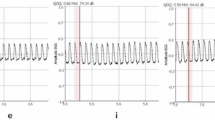Abstract
In-depth study on laryngeal biomechanics and vocal fold vibratory patterns reveal that a single vibratory cycle can be divided into two major phases, the closed and open phase, which is subdivided into opening and closing phases. Studies reveal that the relative time course of abduction and adduction, which in turn is dependent on the relative relaxing and tensing of the vocal fold cover and body, to be the determining factor in production of a particular vocal register like the modal (or chest), falsetto, glottal fry registers. Studies further point out Electroglottography to be particularly suitable for the study of vocal vibratory patterns during register changes. However, to date, there has been limited study on quantitative parameterization of EGG wave form in vocal fry register. Moreover, contradictory findings abound in literature regarding effects of gender and vowel types on vocal vibratory patterns, especially during phonation at different registers. The present study endeavors to find out the effects of vowel and gender differences on the vocal fold vibratory patterns in different registers and how these would be reflected in standard EGG parameters of Contact Quotient (CQ) and Contact Index (CI), taking into consideration the Indian sociolinguistic context. Electroglottographic recordings of 10 young adults (5 males and 5 females) were taken while the subjects phonated the three vowels /a/,/i/,/u/ each in two vocal registers, modal and vocal fry. Obtained raw EGG were further normalized using the Derived EGG algorithm and theCQ and CI values were derived. Obtained data were subject to statistical analysis using the 3-way ANOVA with gender, vowel and vocal register as the three variables. Post-hoc Dunnett C multiple comparison analysis were also performed. Results reveal that CQ values are significantly higher in vocal fry than modal phonation for both males and females, indicating a relatively hyperconstricted vocal system during vocal fry. The males have significantly greater CQ values than females both at modal and vocal fry phonations which indicate that the males are predisposed to greater vocal fold constriction. Females demonstrated no significant increase in CI values in vocal fry state; and in some cases actually decrease in the CI values which suggest an inherently distinct vocal fold physiological adjustment from that in males. No vowel effects were found in any conditions. Perturbation values (CQP and CIP) are significantly more in vocal fry register than in modal register, and the increase was more in case of females than males. The findings give strong evidence to certain hypotheses in literature regarding effects of vowel, gender and phonatory register on vocal fold vibratory patterns.
Similar content being viewed by others
References
Brodnitz FS (1959) Vocal rehabilitation. Whiting Press, Rochester, Minnesota
Chen Y, Robb MP, Gilbert HR (2002) Electroglottographic evaluation of gender and vowel effects during modal and vocal fry phonation. J Speech Hear Res 45:629–821
Childers DG, Krishnamurthy AK (1985) A critical review of electroglottography. Rev Biomed Eng 12:131–161
Childers DG, Lee, CK (1991) Vocal quality factors: analysis, synthesis, and perception. J Acoust Soc Am 90(5):2394–2410
Cooper DS, Partridge LD, Alipour-Haghighi F (1993) Muscle energetics, vocal efficiency, and laryngeal biomechanics. In: Titze IR (ed) Vocal fold physiology: frontiers in basic science. Singular Publishing Group, San Diego, pp 37–92
Gendrot C, Henrich N, Schade G, Muller F, Expert R (2004) Vocal folds vibratory patterns of laryngeal mechanism M0 as investigated with high speed cinematography and electroglottography. In: International conference on voice physiology and biomechanics, Marseille
Henrich N, Roubeau B, Castellengo M (2003) On the use of electroglottography for characterisation of the laryngeal mechanisms. In: Proceedings of the Stockholm Music Acoustics Conference, 6–9 August (SMAC 03), Stockholm
Herbst CT (2004) The EGG contact quotient as a means of assessing vocal registration quality in classical singing. Seminar, Department of Speech, Music and Hearing, Royal Institute of Technology, Stockholm, Sweden
Higgins MB, Saxman JH (1991) A comparison of selected phonatory behaviors of healthy aged and young adults. J Speech Hear Res 34:1000–1010
Higgins MB, Netsell R, Schulte L (1998) Vowel-related differences in laryngeal articulatory and phonatory functions. J Speech Lang Hear Res 41:712–724
Hirano M (1977) Structure and vibratory behaviour of the vocal folds. In: Sawashima M, Cooper FS (eds) Dynamic aspects of speech production. University of Tokyo Press, Tokyo, pp 13–27
Hirano M, Kakita Y (1985) Cover-body theory of vocal cord vibration. In: Daniloff RG (ed) Speech science. College Hill Press, San Diego, pp 1–46
Hollien H (1974) On vocal registers. J Phonetics 2:125–143
Kitzing P (1990) Clinical applications of electroglottography. J Voice 4:3238–3249
Larson CR (1988) Brain mechanisms involved in the control of vocalization. J Voice 2:301–311
Orlikoff F (1991) Assessment of the dynamics of vocal fold contact from the electroglottogram: data from normal male subjects. J Speech Hear Res 34:1066–1072
Roubeau B (1993) Mécanismes vibratoires laryngés et contrôle neuro-musculaire de la fréquence fondamentale. Thèse, Université Paris XI, Orsay
Svec JG, Schutte HK, Sram F (1998) Variability of vibration of normal vocal folds as seen in videokymography. In: Dejonckere P, Peters HFM (eds) Proceedings 24th IALP Congress, pp 122–125
Titze IR, Talkin DT (1979) A theoretical study of the effects of various laryngeal configurations on the acoustics of phonation. J Acoust Soc Am 66:60–74
Timcke, von Leden RH, Moore P (1958) Laryngeal vibrations: measurements of the glottic wave. Part I. The normal vibratory cycle. Arch Otolaryngol 68:1–19
Whitehead RL, Metz DE, Whitehead BH (1984) Vibratory patterns of the vocal folds during pulse register phonation. J Acoust Soc Am 75(4):1293–1297
Zemlin WR (1988) Speech and hearing science: anatomy and physiology. Prentice Hall, Englewood Cliffs
Author information
Authors and Affiliations
Corresponding author
Rights and permissions
About this article
Cite this article
Paul, N., Kumar, S., Chatterjee, I. et al. Electroglottographic Parameterization of the Effects of Gender, Vowel and Phonatory Registers on Vocal Fold Vibratory Patterns: An Indian Perspective. Indian J Otolaryngol Head Neck Surg 63, 27–31 (2011). https://doi.org/10.1007/s12070-010-0099-0
Received:
Accepted:
Published:
Issue Date:
DOI: https://doi.org/10.1007/s12070-010-0099-0




